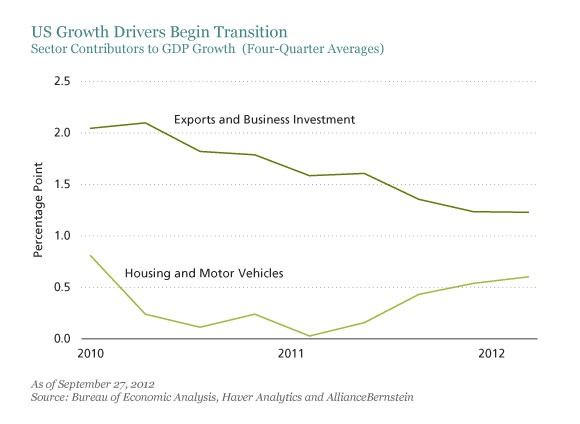Something is changing in the US economic recovery. Housing and autos are finally starting to wake up from a recession-induced slumber, and the timing couldn’t be better.
Since the recession ended in mid-2009, the US economy has been primarily driven by exports and investment. These two sectors, which traditionally drove growth later in a recovery, have recently started to lose steam amid the slowdown in global trade and uncertainty about US fiscal policy, as the display below shows. In contrast, housing and autos, which have always been early cyclical leaders in economic recoveries, are now starting to recover after being stuck in the fallout from the downturn.

To date, the strength of exports and investment alongside the weakness of housing and motor vehicles was an unusual combination. More than two years ago, we described this as a new mix of economic growth drivers. It was just what the economy needed.
At the time, emerging-market economies were growing rapidly, allowing a competitive US manufacturing sector to increase sales abroad. This spurred a strong export cycle, as well as investment spending gains for the US.
Meanwhile, US households were saddled with debt from the credit bust. Because of this, domestic sectors such as motor vehicles and housing weren’t capable of driving the recovery.
Today, US households have made great progress in reducing their debt burden, repairing their balance sheets and improving cash flows. Against this backdrop, I expect an imminent shift back toward the more traditional early cyclical sectors that have powered recoveries in the past. There’s a lot of pent up demand waiting to be released.
Motor vehicle sales had fallen to 10 million units a year in mid-2009, at the start of the economic recovery, the lowest level of any starting point since 1975. Progress has been uneven, but the cumulative gains to date now exceed the rebounds in each of the last three US recoveries.
The same goes for housing. When the recession ended, the US real estate market was hobbled by a massive overhang of unsold homes and even more houses were stuck in the foreclosure pipeline. Now, the pace of the rebound in residential construction (from depressed levels) rivals that of the previous three economic recoveries. And there’s still a long way to go, since new construction is only a little more than half of normal levels of activity.
A recovery in these domestic industries should support more robust and sustainable economic growth by helping to augment job and wealth creation, while fostering improved flows of credit and leading to increased business and consumer confidence. And if the transition of the US economy back toward early cyclical growth drivers continues, I think it would also mark an important new stage for global growth by allowing the US to resume a greater leadership role in the world economy, at a time when other major regional economies are facing significant challenges.
The views expressed herein do not constitute research, investment advice or trade recommendations and do not necessarily represent the views of all AllianceBernstein portfolio-management teams.